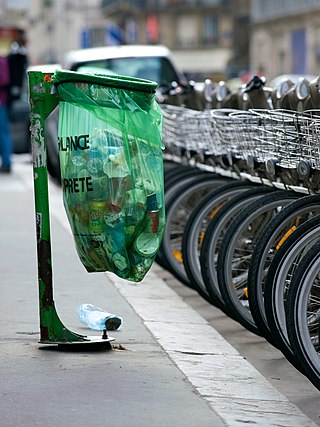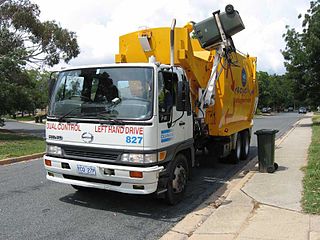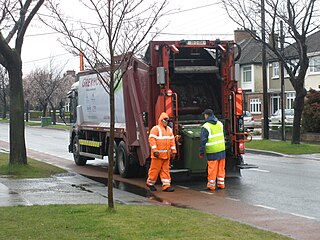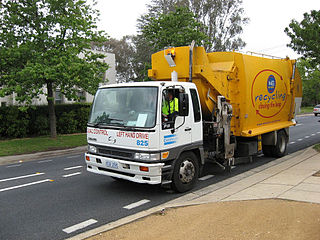Related Research Articles

Dumpster diving is salvaging from large commercial, residential, industrial and construction containers for unused items discarded by their owners but deemed useful to the picker. It is not confined to dumpsters and skips specifically and may cover standard household waste containers, curb sides, landfills or small dumps.

Waste management or waste disposal includes the processes and actions required to manage waste from its inception to its final disposal. This includes the collection, transport, treatment, and disposal of waste, together with monitoring and regulation of the waste management process and waste-related laws, technologies, and economic mechanisms.

A garbage truck is a truck specially designed to collect municipal solid waste and transport it to a solid waste treatment facility, such as a landfill, recycling center or transfer station. In Australia they are commonly called rubbish trucks, or garbage trucks, while in the U.K. dustbin lorry, rubbish lorry or bin lorry is commonly used. Other common names for this type of truck include trash truck in the United States, and refuse truck, dustcart, junk truck, bin wagon or bin van elsewhere. Technical names include waste collection vehicle and refuse collection vehicle (RCV). These trucks are a common sight in most urban areas.
William Laurens Rathje was an American archaeologist. He was professor emeritus of anthropology at the University of Arizona, with a joint appointment with the Bureau of Applied Research in Anthropology, and was consulting professor of anthropological sciences at Stanford University. He was the longtime director of the Tucson Garbage Project, which studied trends in discards by field research in Tucson, Arizona, and in landfills elsewhere, pioneering the field now known as garbology.
Garbology is the study of modern refuse and trash as well as the use of trash cans, compactors and various types of trash can liners. It is a major source of information on the nature and changing patterns in modern refuse, and thereby, human society. Industries wishing to demonstrate that discards originating with their products are important in the trash stream are avid followers of this research, as are municipalities wishing to learn whether some parts of the trash they collect has any salable value.

Litter consists of waste products that have been discarded incorrectly, without consent, at an unsuitable location. The word litter can also be used as a verb: to litter means to drop and leave objects, often man-made, such as aluminum cans, paper cups, food wrappers, cardboard boxes or plastic bottles on the ground, and leave them there indefinitely or for other people to dispose of as opposed to disposing of them correctly.

Illegal dumping, also called fly dumping or fly tipping (UK), is the dumping of waste illegally instead of using an authorised method such as curbside collection or using an authorised rubbish dump. It is the illegal deposit of any waste onto land, including waste dumped or tipped on a site with no licence to accept waste.

A bin bag, rubbish bag, garbage bag, bin liner, trash bag or refuse sack is a disposable receptable for solid waste. These bags are useful to line the insides of waste containers to prevent the insides of the container from becoming coated in waste material. Most bags today are made out of plastic, and are typically black, white, or green in color.
Pay as you throw (PAYT) is a usage-pricing model for disposing of municipal solid waste. Users are charged a rate based on how much waste they present for collection to the municipality or local authority.

Waste collection is a part of the process of waste management. It is the transfer of solid waste from the point of use and disposal to the point of treatment or landfill. Waste collection also includes the curbside collection of recyclable materials that technically are not waste, as part of a municipal landfill diversion program.

A waste container, also known as a dustbin, rubbish bin, trash can, and garbage can, among other names, is a type of container intended to store waste that is usually made out of metal or plastic. The words "rubbish", "basket" and "bin" are more common in British English usage; "trash" and "can" are more common in American English usage. "Garbage" may refer to food waste specifically or to municipal solid waste in general.

Kerbside collection or curbside collection is a service provided to households, typically in urban and suburban areas, of collecting and disposing of household waste and recyclables. It is usually accomplished by personnel using specially built vehicles to pick up household waste in containers that are acceptable to, or prescribed by, the municipality and are placed on the kerb.

A green bin is a large, movable, rigid plastic or metal container that contains biodegradable waste or compostable materials as a means to divert waste from landfills. In some local authorities, green bins are also used to contain unsorted municipal solid waste.
Contemporary archaeology is a field of archaeological research that focuses on the most recent past, and also increasingly explores the application of archaeological thinking to the contemporary world. It has also been referred to as the archaeology of the 'contemporary past'. The use of this term in the United Kingdom is particularly associated with the Contemporary and Historical Archaeology in Theory (CHAT) conference group. The field forms part of historical archaeology, or the archaeology of the modern period. Unlike ethnoarchaeology, contemporary archaeology studies the recent and contemporary past in its own right, rather than to develop models that can inform the study of the more distant past.
Toronto Solid Waste Management Services is the municipal service that handles the transfer and disposal of garbage as well as the processing and sale of recyclable materials collected through the blue box program in Toronto, Ontario, Canada.

Garbage, trash, rubbish, or refuse is waste material that is discarded by humans, usually due to a perceived lack of utility. The term generally does not encompass bodily waste products, purely liquid or gaseous wastes, or toxic waste products. Garbage is commonly sorted and classified into kinds of material suitable for specific kinds of disposal.

Recycling in Australia is a widespread, and comprehensive part of waste management in Australia, with 60% of all waste collected being recycled. Recycling is collected from households, commercial businesses, industries and construction. Despite its prominence, household recycling makes up only a small part (13%) of Australia's total recycling. It generally occurs through kerbside recycling collections such as the commingled recycling bin and food/garden organics recycling bin, drop-off and take-back programs, and various other schemes. Collection and management of household recycling typically falls to local councils, with private contractors collecting commercial, industrial and construction recycling. In addition to local council regulations, legislation and overarching policies are implemented and managed by the state and federal governments.
China's waste import ban, instated at the end of 2017, prevented foreign inflows of waste products. Starting in early 2018, the government of China, under Operation National Sword, banned the import of several types of waste, including plastics with a contamination level of above 0.05 percent. The ban has greatly affected recycling industries worldwide, as China had been the world's largest importer of waste plastics and processed hard-to-recycle plastics for other countries, especially in the West.
Behavioural archaeology is an archaeological theory that expands upon the nature and aims of archaeology in regards to human behaviour and material culture. The theory was first published in 1975 by American archaeologist Michael B. Schiffer and his colleagues J. Jefferson Reid, and William L. Rathje. The theory proposes four strategies that answer questions about past, and present cultural behaviour. It is also a means for archaeologists to observe human behaviour and the archaeological consequences that follow.
Informal waste collection is the activity of "manually sorting and extracting various recyclable and reusable materials from mixed waste, at legal and illegal dumpsites, on top of or under piles of waste, in bins, at various transfer points, in transport trucks or elsewhere". When this activity is carried out in bins, the term "scavenging" is used. This activity is one way of collecting waste, the other ways consisting of collecting it at source or collecting it in an organised way.
References
- ↑ Rybczynski, Witold (July 5, 1992). "We Are What We Throw Away". New York Times . Retrieved 2009-01-23.
- ↑ Rathje & Murphy, 1992. Rubbish!: The Archaeology of Garbage